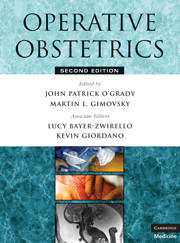Book contents
- Frontmatter
- Contents
- Foreword
- Preface
- Acknowledgments
- Contributors
- Part I ANTEPARTUM
- Part II INTRAPARTUM AND POSTPARTUM
- Part III SURGICAL PROCEDURES
- Part IV SPECIAL ISSUES
- Chapter 22 Fetal Assessment
- Chapter 23 Birth Injuries
- Chapter 24 Midwives and Operative Obstetrics
- Chapter 25 Education and Certification
- Chapter 26 Ethical Issues
- Chapter 27 Perinatal Loss
- Chapter 28 Birth Injury: Legal Commentary IV
- APPENDIX
- Index
- Plate section
- References
Chapter 23 - Birth Injuries
from Part IV - SPECIAL ISSUES
Published online by Cambridge University Press: 07 May 2010
- Frontmatter
- Contents
- Foreword
- Preface
- Acknowledgments
- Contributors
- Part I ANTEPARTUM
- Part II INTRAPARTUM AND POSTPARTUM
- Part III SURGICAL PROCEDURES
- Part IV SPECIAL ISSUES
- Chapter 22 Fetal Assessment
- Chapter 23 Birth Injuries
- Chapter 24 Midwives and Operative Obstetrics
- Chapter 25 Education and Certification
- Chapter 26 Ethical Issues
- Chapter 27 Perinatal Loss
- Chapter 28 Birth Injury: Legal Commentary IV
- APPENDIX
- Index
- Plate section
- References
Summary
Keywords
- Type
- Chapter
- Information
- Operative Obstetrics , pp. 725 - 786Publisher: Cambridge University PressPrint publication year: 2008
References
- 4
- Cited by

